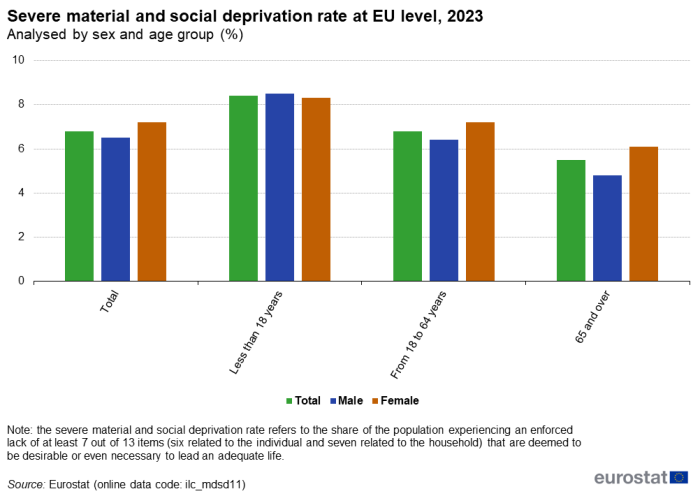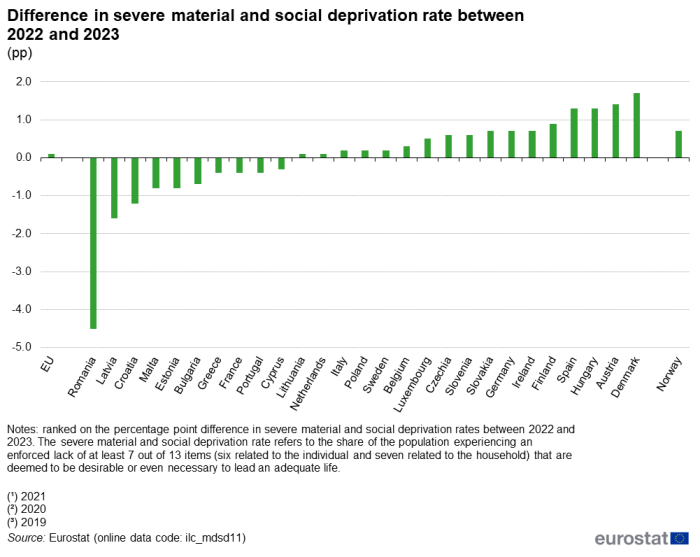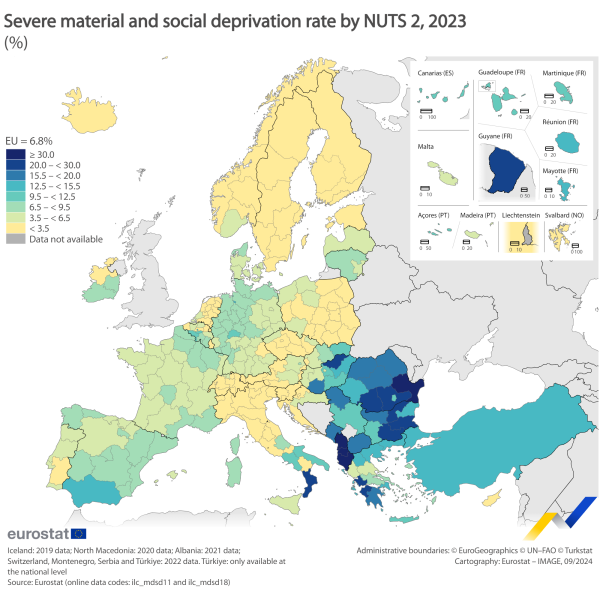Data extracted in July 2024.
Planned article update: 15 September 2025.
Highlights
In 2023, 6.8% or 29.2 million of the EU population faced severe material and social deprivation.
In 2023, females in the EU had a higher rate of severe material and social deprivation (7.2%) compared to males (6.5%).
South-Eastern EU regions reported the highest severe material and social deprivation rates (between 20% and 29.9%) in 2023.
This article focuses on the severe material and social deprivation within the European Union (EU) in 2023. Values are presented at both country and regional NUTS level 2 as well as among different demographic groups.
Key findings
Material and social deprivation refers to the inability to afford a set of specific goods, services, or social activities that are considered by most people as essential for an adequate quality of life. The material and social deprivation rate is defined as the share of the population unable to afford five or more of these thirteen items. The severe material and social deprivation rate applies to those unable to afford seven or more.
In 2023, the rate of severe material and social deprivation in the EU remained relatively stable, with a slight increase from 6.7% in 2022 to 6.8%.
- Persons under 18 and females reported higher levels of severe material and social deprivation than other population groups.
- The highest rates of severe deprivation were observed in Romania at 19.8%, followed by Bulgaria and Greece. In contrast, the lowest rates were recorded in Estonia, Luxembourg, Sweden, Cyprus, and Slovenia, all below 2.5%.
- At a regional level, the highest rate was recorded in Romania’s southeast, exceeding 30%, while most regions in the Nordic countries reported rates below 5%.
- Significant regional disparities were noted, with variations exceeding 15 percentage points (pp), in Greece, Hungary, Italy, Romania, and France. Conversely, Finland, Sweden, Slovenia, and Lithuania exhibited variations of less than 2.0 pp.
Severe material and social deprivation
Females more likely to experience severe material and social deprivation
In 2023, as shown in Figure 1 the EU recorded a slightly higher severe material and social deprivation rate among females (7.2%) compared with males (6.5%). This pattern of higher rates for females is consistent across all observed age groups, except for children under 18 years, where the rate for males (8.5%) was slightly higher than for females (8.3%).
Among persons aged 18 to 64 years, the overall rate was 6.8%, with females (7.2%) having a higher rate than males (6.4%). For the 65 years and over age group, the severe material and social deprivation rate was the lowest, at 5.5%. Notably, males in this age group had a lower rate (4.8%) compared to females (6.1%).

(Analysed by sex and age group (%))
Source: Eurostat (ilc_mdsd11)
Severe material and social deprivation rate in 2023 highest in Romania and lowest in Slovenia
At the EU level, the rate of severe material and social deprivation went from 6.7% in 2022 to 6.8% in 2023, as shown in Figure 2.
In 2023, the highest rates were observed in Romania (19.8%), Bulgaria (18.0%), and Greece (13.5%). Hungary (10.4%) was the only other country with a rate above 10%. Conversely, Slovenia (2.0%), Cyprus (2.4%), Sweden (2.5%), Luxembourg (2.5%), and Estonia (2.5%) recorded the lowest rates.
Between 2022 and 2023, the largest reductions in severe material and social deprivation rates were observed in Romania (down 4.5pp ), Latvia (down 1.6 pp) and Croatia (down 1.2 pp), as shown in Figure 3. Smaller declines, below 1.0 pp, were recorded in Malta, Estonia, Bulgaria, Greece, France, and Portugal. In contrast, the largest increases were observed in Denmark (up 1.7 pp), Austria (up 1.4 pp), Hungary (up 1.3 pp) and Spain (up 1.3 pp).

(pp)
Source: Eurostat (ilc_mdsd11)
South-Eastern EU regions reported the highest severe material and social deprivation rates
Map 1 illustrates the occurrence of severe material and social deprivation rates at regional NUTS level 2 in 2023. Among all EU regions, Romania’s south-eastern region recorded the highest regional share of severe material and social deprivation, with more than 30% of the population facing such conditions.
Across the EU, nine regions had a share of people experiencing severe material and social deprivation ranging from 20.0% to 29.9%. These regions are primarily located in southern and eastern EU countries, except for one region in France's overseas department. Specifically, they include two regions in Romania, three regions in Bulgaria one region in Hungary, one region in Italy and one region in Greece. Conversely, most regions in the EU Nordic countries, as well as in Estonia, Poland, Slovenia, Czechia, the Netherlands, Luxembourg, Italy, Croatia and Malta and Cyprus had severe material and social deprivation rates below 3.5%.

(%)
Source: Eurostat (ilc_mdsd11) and (ilc_mdsd18)
France, Italy, Romania, Hungary and Greece showed significant inter-regional differences in severe material and social deprivation rates. The difference between the highest and lowest rates within these EU countries were 22.2 pp, 19.9 pp, 19.7 pp 16.9 pp and 15.8 pp, respectively. By contrast, inter-regional differences were less than 2.0 pp in Slovenia, Finland and Lithuania.

(pp)
Source: Eurostat (ilc_mdsd18)
Source data for tables and graphs
Data sources
The data used in this article are derived from the EU Statistics on income and living conditions (EU-SILC). EU-SILC data are compiled annually and are the main source of statistics that measure income and living conditions in Europe; it is also the main source of information used to link different aspects relating to the quality of life of households and individuals.
The reference population for the information presented in this article is all private households and their current members residing in the territory of an EU Member State (or non-member country) at the time of data collection; persons living in collective households are generally excluded from the target population. The data for the EU are population-weighted averages of national data. The reference period for individuals' characteristics is 2023. The data is available for the 27 Member States as well as Norway, Switzerland, Iceland and Serbia, Montenegro, North Macedonia, Albania and Türkiye.
Context
The list of thirteen deprivation items used to define material and social deprivation consists of seven household-related and six individual-related elements:
At the household level:
- Capacity to face unexpected expenses;
- Capacity to afford paying for one week annual holiday away from home;
- Capacity to being confronted with payment arrears (on mortgage or rental payments, utility bills, hire purchase instalments or other loan payments);
- Capacity to afford a meal with meat, chicken, fish or vegetarian equivalent every second day;
- Ability to keep home adequately;
- Have access to a car/van for personal use;
- Replacing worn-out furniture.
At the individual level:
- Having internet connection;
- Replacing worn-out clothes by some new ones;
- Having two pairs of properly fitting shoes (including a pair of all-weather shoes);
- Spending a small amount of money each week on him/herself;
- Having regular leisure activities;
- Getting together with friends/family for a drink/meal at least once a month.
This measure complements the relative analysis of monetary poverty by providing information on absolute poverty.
The severe material and social deprivation indicator (SMSD) is part of the at risk of poverty or social exclusion rate defined in the framework of the EU 2030 target on poverty and social exclusion.
The severe material and social deprivation indicator (SMSD) is part of the at risk of poverty or social exclusion rate (AROPE). The AROPE ratio is the share of the total population which is at risk of poverty or social exclusion. The headline target (EU2030 target) on poverty and social inclusion of the European Pillar of Social Rights Action Plan is to reduce the number of people at risk of poverty or social exclusion by at least 15 million by 2030. Progress towards this target is monitored through the AROPE rate, published by Eurostat.
Explore further
Other articles
- All articles from Living condtions
- Living conditions in Europe — poverty and social exclusion
Thematic section
Selected datasets
Methodology
External links
Legislation
- Detailed list of legislative information on EU-SILC provisions for survey design, survey characteristics, data transmission and ad-hoc modules
- Regulation (EC) No 2019/1700 — — the central piece of legislation for social surveys including EU-SILC
- Regulation (EC) No 2019/2242 — — additional central piece of legislation for EU-SILC

